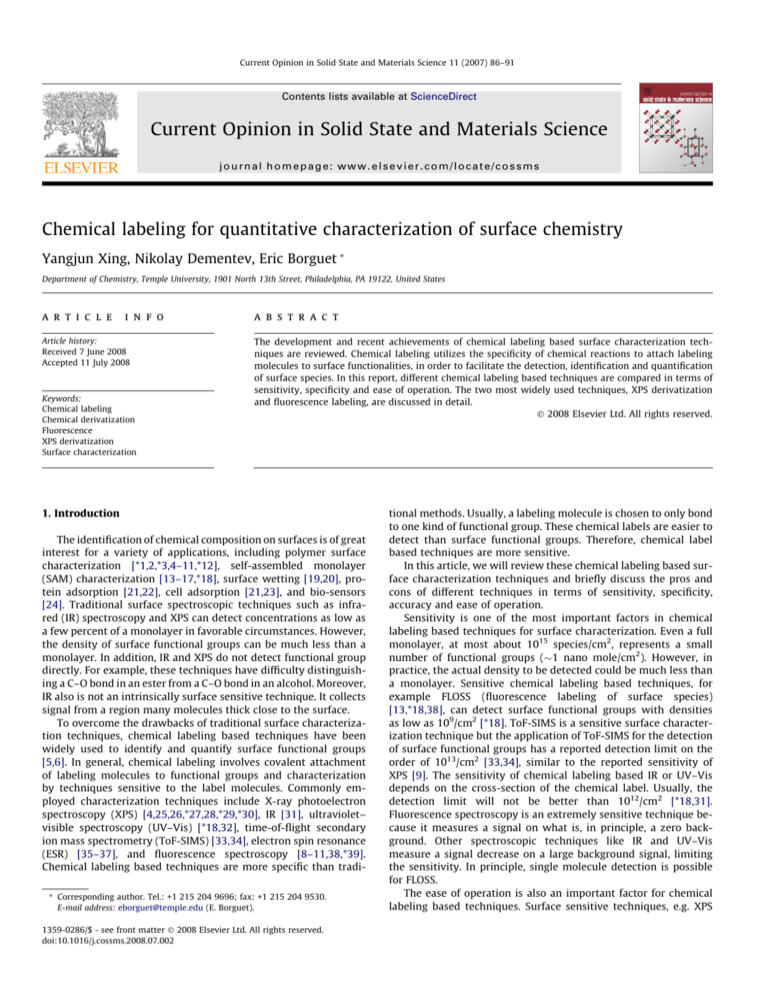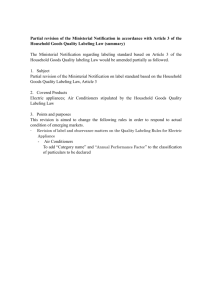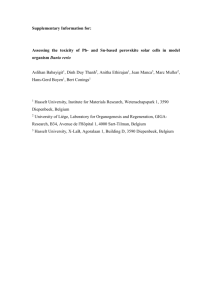
Current Opinion in Solid State and Materials Science 11 (2007) 86–91
Contents lists available at ScienceDirect
Current Opinion in Solid State and Materials Science
journal homepage: www.elsevier.com/locate/cossms
Chemical labeling for quantitative characterization of surface chemistry
Yangjun Xing, Nikolay Dementev, Eric Borguet *
Department of Chemistry, Temple University, 1901 North 13th Street, Philadelphia, PA 19122, United States
a r t i c l e
i n f o
Article history:
Received 7 June 2008
Accepted 11 July 2008
Keywords:
Chemical labeling
Chemical derivatization
Fluorescence
XPS derivatization
Surface characterization
a b s t r a c t
The development and recent achievements of chemical labeling based surface characterization techniques are reviewed. Chemical labeling utilizes the specificity of chemical reactions to attach labeling
molecules to surface functionalities, in order to facilitate the detection, identification and quantification
of surface species. In this report, different chemical labeling based techniques are compared in terms of
sensitivity, specificity and ease of operation. The two most widely used techniques, XPS derivatization
and fluorescence labeling, are discussed in detail.
Ó 2008 Elsevier Ltd. All rights reserved.
1. Introduction
The identification of chemical composition on surfaces is of great
interest for a variety of applications, including polymer surface
characterization [*1,2,*3,4–11,*12], self-assembled monolayer
(SAM) characterization [13–17,*18], surface wetting [19,20], protein adsorption [21,22], cell adsorption [21,23], and bio-sensors
[24]. Traditional surface spectroscopic techniques such as infrared (IR) spectroscopy and XPS can detect concentrations as low as
a few percent of a monolayer in favorable circumstances. However,
the density of surface functional groups can be much less than a
monolayer. In addition, IR and XPS do not detect functional group
directly. For example, these techniques have difficulty distinguishing a C–O bond in an ester from a C–O bond in an alcohol. Moreover,
IR also is not an intrinsically surface sensitive technique. It collects
signal from a region many molecules thick close to the surface.
To overcome the drawbacks of traditional surface characterization techniques, chemical labeling based techniques have been
widely used to identify and quantify surface functional groups
[5,6]. In general, chemical labeling involves covalent attachment
of labeling molecules to functional groups and characterization
by techniques sensitive to the label molecules. Commonly employed characterization techniques include X-ray photoelectron
spectroscopy (XPS) [4,25,26,*27,28,*29,*30], IR [31], ultraviolet–
visible spectroscopy (UV–Vis) [*18,32], time-of-flight secondary
ion mass spectrometry (ToF-SIMS) [33,34], electron spin resonance
(ESR) [35–37], and fluorescence spectroscopy [8–11,38,*39].
Chemical labeling based techniques are more specific than tradi* Corresponding author. Tel.: +1 215 204 9696; fax: +1 215 204 9530.
E-mail address: eborguet@temple.edu (E. Borguet).
1359-0286/$ - see front matter Ó 2008 Elsevier Ltd. All rights reserved.
doi:10.1016/j.cossms.2008.07.002
tional methods. Usually, a labeling molecule is chosen to only bond
to one kind of functional group. These chemical labels are easier to
detect than surface functional groups. Therefore, chemical label
based techniques are more sensitive.
In this article, we will review these chemical labeling based surface characterization techniques and briefly discuss the pros and
cons of different techniques in terms of sensitivity, specificity,
accuracy and ease of operation.
Sensitivity is one of the most important factors in chemical
labeling based techniques for surface characterization. Even a full
monolayer, at most about 1015 species/cm2, represents a small
number of functional groups (1 nano mole/cm2). However, in
practice, the actual density to be detected could be much less than
a monolayer. Sensitive chemical labeling based techniques, for
example FLOSS (fluorescence labeling of surface species)
[13,*18,38], can detect surface functional groups with densities
as low as 109/cm2 [*18]. ToF-SIMS is a sensitive surface characterization technique but the application of ToF-SIMS for the detection
of surface functional groups has a reported detection limit on the
order of 1013/cm2 [33,34], similar to the reported sensitivity of
XPS [9]. The sensitivity of chemical labeling based IR or UV–Vis
depends on the cross-section of the chemical label. Usually, the
detection limit will not be better than 1012/cm2 [*18,31].
Fluorescence spectroscopy is an extremely sensitive technique because it measures a signal on what is, in principle, a zero background. Other spectroscopic techniques like IR and UV–Vis
measure a signal decrease on a large background signal, limiting
the sensitivity. In principle, single molecule detection is possible
for FLOSS.
The ease of operation is also an important factor for chemical
labeling based techniques. Surface sensitive techniques, e.g. XPS
Y. Xing et al. / Current Opinion in Solid State and Materials Science 11 (2007) 86–91
and SIMS, need to be operated in UHV environment and the sample
may be destroyed as a result of the measurement. Spectroscopic
based techniques (fluorescence, IR and UV–Vis) do not require
the vacuum environment necessary for XPS and SIMS and are in
principle non-destructive. These features are critical when analyzing biological samples. In addition, by choosing a reversible labeling reaction, the initial surface can be recovered after chemical
labeling.
The specificity and accuracy of chemical labeling are of critical
importance. An ideal labeling reaction should have two characteristics. The first is that the labeling molecules should bond to only
one kind of functional group, and not bond to other groups. Second,
the reaction should be complete in a short time, leaving very few
groups unlabeled. The degree of completion of labeling reactions
may affect the accuracy of chemical labeling based techniques.
One of the challenges for chemical labeling based techniques is
to translate the relative signal measured from the instrument to an
absolute number of surface functional groups. The convenience
and accuracy of the calibration process are critical for quantifying
the functional group density.
It should be kept in mind that these chemical labeling based
techniques are not suitable for analyzing high concentrations of
surface functional groups, i.e. close to a full monolayer. The labeling molecule usually occupies more space than a small functional
group. Therefore, functional groups that are close to each other will
not be labeled completely. In these cases, chemical labeling based
techniques may underestimate the concentration of surface functional groups. This effect is more critical for fluorescence labeling,
since the fluorescence signal may be quenched if the fluorescent
dyes interact with each other. The upper detection limit of chemical labeling based techniques depends on the size of labeling
molecules.
There are two kinds of chemical labeling techniques. The first is
direct characterization, which detects the chemical label bound to
the surface directly. The second one, indirect characterization, is
useful for situations where direct surface detection is not applicable. In such cases, for example, the chemical label is released from
the surface to a solution and solution phase detection is performed.
This procedure requires reversible chemical labeling reactions.
Reversible reactions are also of interest for applications that require the recovery of the original surface after surface
characterization.
In this review, we will focus on the two most widely used chemical labeling based surface characterization techniques: XPS derivatization and FLOSS.
87
2. XPS derivatization
X-ray photoelectron spectroscopy (XPS) has been widely used
to determine the nature of functionalities on the surface of polymers [4,25,26,30,40–44], carbon fibers [26,45,46], and carbon
blacks [*27–29]. While XPS mostly provides information about
the atomic composition of the surfaces, it can also provide some
details about the oxidation states of the elements. XPS is sensitive
to functional groups located within the mean free path (1 nm for
electron energies in the range 10–500 eV) of the surface, typically
much shorter than the X-ray penetration depth (>microns) [47].
The theory and practice of XPS is discussed in detail in a number
of reviews [48] and textbooks [47,49]. However, obtaining quantitative information typically requires a deconvolution of peaks in
XPS spectra, which decreases the reliability of the results
[28,*29]. In addition, XPS cannot unambiguously identify functional groups. For example, while a peak might be interpreted as
arising from a C atom bound by a single covalent bond to O, XPS
data alone cannot distinguish whether this C–O is associated with
an ether or an alcohol.
To overcome the ambiguity that might result from deconvolution, and to identify functional groups rather than chromophores,
selective chemical derivatization (CD) of functional groups (Fig. 1)
can be performed prior to XPS measurements [25,26,28,*29,44].
The determination of functional groups in this case is based on
the detection of atoms present in the CD agent that are not present
in the surface prior to CD [25,26,28,*29,44]. XPS was used to determine and quantify functional groups on polytetrafluoroethylene
(PTFE) surfaces after radio frequency glow discharge (RFGD) treatment in ammonia, supposedly to improve hemocompatibility of
PTFE vascular protheses [41]. Benzaldehyde derivatives (chlorobenzaldehyde and bromosalicylaldehyde) and molecular bromine
were used to label amino groups and carbon–carbon double bonds,
respectively [41]. CD-XPS revealed increased concentration of
amine surface groups as a result of the RFGD treatment [41].
Black carbons (BC) (wood chars and soot, diesel soot, hexane
soot), which have found applications as sorbents due to their high
specific surface area, are believed to contain many different kinds
of oxygen functionalities (Fig. 1) [28,*29]. CD-XPS analysis of was
performed on BC [28]. Carboxyls, carbonyls and hydroxyls were
identified and their concentrations were determined [28]. Trifluoroacetic anhydride (TFAA), trifluoroethanol (TFE), and trifluoroethyl hydrazine (TFH) were used to label hydroxyl, carboxylic,
and carbonyl groups, respectively (Fig. 2) [28]. The XPS signal from
fluorine, present in the CD derivatives but not in the original black
Fig. 1. Examples of chemical derivatization of hydroxyl, carbonyl, and carboxyl functional groups by fluorine containing derivatizing agents. Reprinted with permission from
[*29]. Copyright (2006) Elsevier.
88
Y. Xing et al. / Current Opinion in Solid State and Materials Science 11 (2007) 86–91
Fig. 2. Possible oxygen containing functionalities on the graphene sheet structure of black carbons. Reprinted with permission from [28]. Copyright (2006) American
Chemical Society.
carbons, was used to determine the concentration of each functionality [28]. It was found that carboxyls are not the most abundant oxides, compared to hydroxyls and carbonyls. In addition,
the results suggested that oxides, other than hydroxyls, carboxyls,
and carbonyls, were present [28]. A comparison of XPS and energy
dispersive spectroscopy, a bulk sensitive technique, showed that
the concentration of oxides on the surface of black carbons was
several times bigger (5 times) than in the bulk [28].
A similar XPS labeling strategy was recently used to investigate
the distribution of oxides on natural BC after oxidation treatments
with hydrogen peroxide, ozone, nitric acid, and ammonium persulfate [*29]. As-produced black carbons had significant oxide content
(12%) and ozone was the most aggressive oxidant compared to
H2O2, or HNO3. Interestingly, persulfate was found to be a highly
selective oxidant, selectively increasing the concentration of carboxylic groups [*29]. The detection limit of CD-XPS technique is
estimated to be 1013 groups/cm2 (1010 mol/cm2) [9].
XPS CD has been used, together with voltammetric techniques,
for quantification of carboxylic groups on the surface of SWCNTs
and Multi Walled Carbon Nanotubes (MWCNTs), via emission of
N1s electrons from nitrogen in the 4-Nitrophenol (4-NP) labels
[50]. The same research group used XPS CD for the relative quantification of ortho-and para-quinone functionality on graphite, glassy
carbon, and carbon nanotubes [51].
3. Fluorescence labeling of surface species (FLOSS)
Fluorescence labeling is a promising method for the detection
and quantification of surface functional groups because of the high
sensitivity of fluorescence spectroscopy. In addition, fluorescence
spectroscopy is easy to operate, and can be applied in situ. It has
been widely used in biological applications [52–60], polymer
chemistry [2,*3,5–10,39] and the study of self-assembled monolayers [13–17]. It has been demonstrated that the chemical labeling
based fluorescence techniques are able to identify and quantify
surface functionalities down to 109 groups/cm2 [*18], which
makes fluorescence based detection 10,000 times more sensitive
than the CD XPS methods [9,*18]. The idea of using fluorescence
labeling to study polymer surfaces was introduced in the 1980s
by Whitesides [11]. Dansyl cadaverine was used to label carboxylic
acid groups at the surface of acid-treated polyethylene (PE) and
characterized by fluorescence spectroscopy [11].
The first paper, to our knowledge, that systematically described
fluorescence labeling as a surface characterization technique was
published in 1996, where the authors described four reaction
schemes for the labeling of carboxylic acid, alcohol, ketone and
amine groups on polyethylene (PE) surfaces [9]. The calibration
of fluorescence was done by a so called ‘depletion method’. Nonmodified PE films were immersed in fluorescence dye solutions
of different concentrations, allowing adsorption of dye molecules
onto the films. Afterwards the PE films were washed in ethanol
to remove the dye molecules on the surface. Fluorescence signals
were collected from these samples before and after washing dye
off the films and were compared to the fluorescence signals of
the dyes washed off and measured in ethanol, the latter providing
an absolute measure of the number of dye molecules removed [9].
However, it is difficult to obtain an accurate calibration curve by
the ‘surface depletion method’ when the concentration transferred
into solution is small.
In 2004, McArthur et al. extended fluorescent labeling for quantitative surface analysis to self-assembled monolayers (SAM) in
their analysis of the photoreaction of octadecyltrichlorosilane
(OTS) SAMs on silicon dioxide (Fig. 3) [38]. They employed a simple
calibration method involving the deposition of known numbers of
fluorescent dye molecules on an OTS SAM surface by a ‘drop and
dry’ method. A known volume of diluted dye solution was dropped
onto a defined area of the SAM surface and fluorescence measurements were taken. The fluorescence signals were plotted versus total volume of drops deposited on the surface (i.e. number of dye
molecules), and show a linear behavior (inset of Fig. 3) suggesting
that saturation is not an issue in the range explored. This calibration procedure is fast, accurate and easy to perform. It provides a
simple relation between the fluorescence signal detected from
the surface and the density of surface functional groups. Using this
Fig. 3. Emission spectra of 1-pyrenemethylamine reacted with 30 min UV-irradiated ODS SAM (solid), unirradiated ODS SAM (dashed), and SiO2 (dotted). Inset:
calibration plot. Reprinted with permission from [38]. Copyright (2004) American
Chemical Society.
89
Y. Xing et al. / Current Opinion in Solid State and Materials Science 11 (2007) 86–91
technique, the concentrations of oxygen containing functionalities
on the OTS SAM surface were measured as a function of UV irradiation time (Fig. 3) [38]. It was observed that number of oxygen
containing functionalities increased as a function of the irradiation
time, with aldehyde and carboxylic species being the predominant
groups under their conditions. The results on total oxygen functionality correlated with the contact angle, IR and AFM measurements [13].
It should be noted that, although the calibration curves in Figs. 3
and 4 appear linear, this may not always be the case. As the fluorescence dye density increases on the surface, fluorescence
quenching may become more significant, decreasing the fluorescence yield per molecule. From this point of view, it is important
to use calibration curves that explore a similar signal range as
the FLOSS signal. As discussed earlier, quenching effects may limit
the highest surface functional density that FLOSS can detect.
The specificity of FLOSS was studied by checking the interference of carboxyl group on the detection of aldehyde groups by
amine modified dyes [18]. It was found that, after a proper postcleaning procedure (rinsed twice with neat methanol and then
sonicated successively in less polar solutions (CH2Cl2, acetone,
and hexane) for 10 min, respectively) to remove dye molecules
weakly adsorbed on the surface, the number of carboxyl-modified
dyes still bound to the surface was 0.36% of the number of aldehyde-modified dyes. This result indicates that the presence of carboxyl groups does not affect significantly the detection of aldehyde
groups (Fig. 4) [18]. By choosing appropriate dyes, FLOSS can be applied to variety of surfaces, including polymer, silicon, glass, carbonaceous materials and particles.
3.1. FLOSS of carbon materials
Fig. 4. (A) Fluorescence detection of two D2183-reacted amine coated slides
(D2183 is a carboxyl terminated fluorescence probe provided by Invitrogen, 4,4difluoro-5,7-dimethyl-4-bora-3a,4a-diaza-s-indacene-3-propionic acid). One sample is only rinsed in MeOH twice after the reaction (solid line), the other sample is
subjected to the full post-reaction cleaning procedure (dashed line). The dasheddotted line is the intrinsic fluorescence of the clean amine-coated slide. (B)
Calibration curve. All samples were excited at 470 nm. Reprinted with permission
from [*18]. Copyright (2007) American Chemical Society.
FLOSS has been applied to carbonaceous materials, for example,
carbon fibers [61], and single-walled carbon nanotubes (SWCNTs)
[62]. The fluorescent active moieties act as ‘‘beacons” upon covalent attachment to the specific functional groups on the surface
(Fig. 5) [62].
FLOSS on carbon fibers was performed using 1-naphthaleneethanol, 1-pyrenemethylamine, and triphenylmethylchloride to label
carboxylic, carbonyl, and hydroxyl groups, respectively, revealing
low concentrations (1012 groups/cm2) of CHO and CO2H groups,
while the hydroxyl groups were below the detection limit
(1010/cm2) [61]. It is worth noting, that contrary to the Boehm
titration analysis, FLOSS detects primarily oxygen containing functionalities on external carbon fiber surfaces, and molecularly accessible pores rather that in pores smaller than FLOSS probes (i.e.
<1.5 nm). FLOSS provides knowledge of the surface functionality
which is a key to applications such as the dispersion of carbon fibers for the formation of composites. Differences between FLOSS
and Boehm titration will occur when materials contain pores that
might be too small to be accessible for FLOSS label molecules [61].
Boehm titration does not differentiate between oxygen groups on
the external surface, in molecularly large or small pores [61].
FLOSS experiments on SWCNTs used dansyl hydrazine (DH),
panacyl bromide (PB), and 5-DTAF to label carbonyls, carboxyls,
and hydroxyls, respectively [62]. The results of FLOSS on SWCNTs
were consistent with the Boehm titration results, implying that
all functional groups on SWCNTs are accessible to the FLOSS fluorophores [62]. According to FLOSS, even as-received arc-produced
SWCNTs (which are supposed to be almost defect free) have
>0.6% content of total oxygen containing functional groups. The
more aggressive the oxidative purification technique used, the
O
O
O
O
O
Br
O
COOH
COO
3.5h, 50 0C
crown ether
catalyst in
acetone
+ HBr
Fig. 5. Fluorescence labeling of carboxylic groups on single-walled carbon nanotubes by panacyl bromide.
90
Y. Xing et al. / Current Opinion in Solid State and Materials Science 11 (2007) 86–91
5. Summary
We have reviewed most of the commonly used chemical labeling based surface characterization techniques with a focus on XPS
and fluorescence characterizations. We discussed the advantages
and limitations of each technique. Among all of the characterization techniques, FLOSS is probably the most promising one because
of its high sensitivity, ease of operation, and in situ applicability.
However, more systematic work needs to be done to investigate
the specificity and accuracy of chemical labeling reactions. As fluorescence spectroscopy is in principle capable of single molecule
detection, more effort is needed to reach this limit of sensitivity
and even the development of FLOSS based chemical microscopy.
Acknowledgement
The authors acknowledge the generous support of the DOE, Office of Basic Energy Sciences (DE-FG02-05ER15638).
References
The papers of particular interest have been highlighted as:
* of special interest.
Fig. 6. Fluorescence detection (A) and UV–Vis detection (B) of D2371-reacted glass
slide E (epoxy-coated). Reprinted with permission from [*18]. Copyright (2007)
American Chemical Society. (D2371 is an aldehyde reactive fluorescence probe
provided by Invitrogen, 4,4-difluoro-5,7-dimethyl-4-bora-3a,4a-diaza-s-indacene3-propionic acid, hydrazide.)
greater the concentrations of oxygen-containing functionalities
on SWCNTs. Somewhat surprisingly, carbonyls are the most
abundant oxygen containing functionalities on HNO3 treated
SWCNTs, suggesting that the chemical modifications of SWCNTs
should include the chemistry of carbonyls as well as that of
carboxyls.
4. Other chemical labeling based surface characterization
techniques
Absorption spectroscopy techniques like UV–Vis can be used to
determine the concentration of surface bound chemical labels
[*18,32]. One advantage is that UV–Vis spectrometers are routine
instruments and can be accessed easily. The operation procedure
for UV–Vis is relatively simple compared to other techniques. Furthermore, the signal measured can be translated to absolute concentration value based on the Beer–Lambert law, so no
complicated calibration procedure is needed. However, sensitivity
of UV–Vis spectroscopy is limited as illustrated in Fig. 6 [*18].
Similar to XPS, SIMS is also a sensitive surface characterization
technique. There are a few reports using chemical labeling based
ToF-SIMS to quantify the concentration of carboxyl group and
amine group polymer surfaces [33,34]. The detection limit is estimated to be 1013/cm2 [33,34]. However, we are not aware of any
systematic study of chemical labeling based ToF-SIMS techniques,
probably due to the lack of access to this instrument and complicated operating and calibration procedures. As a result, the detection limit may not be fully optimized.
Electron spin resonance (ESR) of chemically bound spin-labels
has been applied to the quantitative study of functional group density [35–37]. ESR active spin labels are chemically attached to functional groups and the ESR signal is measured. Similar to SIMS,
chemical labeling based ESR characterization has not been fully
explored.
[*1] Hollander A, Kropke S, Pippig F. Chemical analysis of functionalized polymer
surfaces. Surf Interface Anal 2008:379–85.
[2] Meyer S, Pescador P, Donath E. Fluorescence boost in polyelectrolyte
multilayer architectures. J Phys Chem C 2008;112(5):1427–34.
[*3] Seixas de Melo J, Costa T, Francisco A, Macanita AL, Gago S, Goncalves IS.
Dynamics of short as compared with long poly(acrylic acid) chains
hydrophobically modified with pyrene, as followed by fluorescence
techniques. Phys Chem Chem Phys 2007;9(11):1370–85.
[4] Yegen E, Lippitz A, Treu D, Unger WES. Derivatization of amino groups by
pentafluorobenzaldehyde (PFB) as observed by XPS and NEXAFS spectroscopy
on spin coated 4,40 -methylenebis(2,6-diethylaniline) films. Surf Interface Anal
2008;40(3–4):176–9.
[5] Herold M, Brunner H, Tovar GEM. Polymer nanoparticles with activated ester
surface by using functional surfmers. Macromol Chem Phys 2003;204(5–
6):770–8.
[6] Hofstraat JW, vanHouwelingen GDB, Schotman AHM, Nuijens MJ, Gooijer C,
Velthorst NH, et al. Near-IR fluorescent labels for determination of functional
groups in polymeric materials. Polymer 1997;38(16):4033–41.
[7] Lee KB, Yoon KR, Woo SI, Choi IS. Surface modification of poly(glycolic acid)
(PGA) for biomedical applications. J Pharmaceut Sci 2003;92(5):933–7.
[8] Wang WL, He QG, Zhai J, Yang JL, Bai FL. Self-assembled hyperbranched
poly(para-phenylene vinylene) monolayers: fabrication and characterization.
Polym Adv Technol 2003;14(3–5):341–8.
[9] Ivanov VB, Behnisch J, Hollander A, Mehdorn F, Zimmermann H.
Determination of functional groups on polymer surfaces using fluorescence
labelling. Surf Interface Anal 1996;24(4):257–62.
[10] Hollander A. Labelling techniques for the chemical analysis of polymer
surfaces. Surf Interface Anal 2004;36(8):1023–6.
[11] Holmesfarley SR, Whitesides GM. Fluorescence properties of dansyl groups
covalently bonded to the surface of oxidatively functionalized low-density
polyethylene film. Langmuir 1986;2(3):266–81.
[*12] Ghasemi M, Minier M, Tatoulian M, Arefi-Khonsari F. Determination of amine
and aldehyde surface densities: application to the study of aged plasma
treated polyethylene films. Langmuir 2007;23(23):11554–61.
[13] Ye T, McArthur EA, Borguet E. Mechanism of UV photoreactivity of alkylsiloxane
self-assembled monolayers. J Phys Chem B 2005;109(20):9927–38.
[14] Flink S, van Veggel F, Reinhoudt DN. Functionalization of self-assembled
monolayers on glass and oxidized silicon wafers by surface reactions. J Phys
Org Chem 2001;14(7):407–15.
[15] Fox MA, Li WJ, Wooten M, McKerrow A, Whitesell JK. Fluorescence probes for
chemical reactivity at the interface of a self-assembled monolayer. Thin Solid
Films 1998;329:477–80.
[16] Montalti M, Prodi L, Zaccheroni N, Baxter R, Teobaldi G, Zerbetto F. Kinetics of
place-exchange reactions of thiols on gold nanoparticles. Langmuir
2003;19(12):5172–4.
[17] Sagiv J. Organized monolayers by adsorption. 1. Formation and structure of
oleophobic mixed monolayers on solid-surfaces. J Am Chem Soc 1980;102(1):
92–8.
[*18] Xing YJ, Borguet E. Specificity and sensitivity of fluorescence labeling of
surface species. Langmuir 2007;23(2):684–8.
[19] Atre SV, Liedberg B, Allara DL. Chain-length dependence of the structure and
wetting properties in binary composition monolayers of OH-terminated and
CH3-terminated alkanethiolates on gold. Langmuir 1995;11(10):3882–93.
[20] Israelachvili JN, Gee ML. Contact angles on chemically heterogeneous
surfaces. Langmuir 1989;5(1):288–9.
Y. Xing et al. / Current Opinion in Solid State and Materials Science 11 (2007) 86–91
[21] Guignet EG, Segura J-M, Hovius R, Vogel H. Repetitive reversible labeling of
proteins at polyhistidine sequences for single-molecule imaging in live cells.
ChemPhysChem 2007;8(8):1221–7.
[22] Mrksich M, Whitesides GM. Using self-assembled monolayers to understand
the interactions of man-made surfaces with proteins and cells. Ann Rev
Biophys Biomol Struct 1996;25:55–78.
[23] Roberts C, Chen CS, Mrksich M, Martichonok V, Ingber DE, Whitesides GM.
Using mixed self-assembled monolayers presenting RGD and (EG)(3)OH
groups to characterize long-term attachment of bovine capillary endothelial
cells to surfaces. J Am Chem Soc 1998;120(26):6548–55.
[24] Flink S, van Veggel F, Reinhoudt DN. Sensor functionalities in self-assembled
monolayers. Adv Mater 2000;12(18):1315–28.
[25] Popat RP, Sutherland I, Sheng ES. Vapor-phase chemical derivatization for the
determination of surface functional-groups by X-ray photoelectronspectroscopy. J Mater Chem 1995;5(5):713–7.
[26] Povstugar VI, Mikhailova SS, Shakov AA. Chemical derivatization techniques
in the determination of functional groups by X-ray photoelectron
spectroscopy. J Anal Chem 2000;55(5):405–16.
[*27] Kondo H, Nishida Y. Quantitative analysis of surface functional groups on the
amorphous carbon in magnetic media with XPS preceded by chemical
derivatization. Bull Chem Soc Jpn 2007;80(7):1405–12.
[28] Langley LA, Villanueva DE, Fairbrother DH. Quantification of surface oxides on
carbonaceous materials. Chem Mater 2006;18(1):169–78.
[*29] Langley LA, Fairbrother DH. Effect of wet chemical treatments on the
distribution of surface oxides on carbonaceous materials. Carbon
2007;45(1):47–54.
[*30] Kogoma M, Hashimoto S, Tanaka K. Surface modification of polyethylene
powder by atmospheric pressure glow plasma. J Photopolym Sci Technol
2006;19(2):231–4.
[31] Fairbank RWP, Wirth MJ. Role of surface-adsorbed water in the horizontal
polymerization of trichlorosilanes. J Chromatogr A 1999;830(2):285–91.
[32] Moon JH, Shin JW, Kim SY, Park JW. Formation of uniform aminosilane thin
layers: an imine formation to measure relative surface density of the amine
group. Langmuir 1996;12(20):4621–4.
[33] Medard N, Aouinti M, Poncin-Epaillard F, Bertrand P. ToF-SIMS ability to
quantify surface chemical groups: correlation with XPS analysis and
spectrochemical titration. Surf Interface Anal 2001;31(11):1042–7.
[34] Kim J, Shon HK, Jung D, Moon DW, Han SY, Lee TG. Quantitative chemical
derivatization technique in time-of-flight secondary ion mass spectrometry
for surface amine groups on plasma-polymerized ethylenediamine film. Anal
Chem 2005;77(13):4137–41.
[35] Martini G. Electron-spin-resonance in surface science. Colloid Surface
1990;45:83–133.
[36] Singh RJ, Feix JB, McHaourab HS, Hogg N, Kalyanaraman B. Spin-labeling
study of the oxidative damage to low-density-lipoprotein. Arch Biochem
Biophys 1995;320(1):155–61.
[37] Khramtsov VV, Yelinova VI, Weiner LM, Berezina TA, Martin VV, Volodarsky
LB. Quantitative-determination of Sh-groups in low-molecular-weight and
high-molecular-weight compounds by an electron-spin resonance method.
Anal Biochem 1989;182(1):58–63.
[38] McArthur EA, Ye T, Cross JP, Petoud S, Borguet E. Fluorescence detection of
surface-bound intermediates produced from UV photoreactivity of
alkylsiloxane SAMs. J Am Chem Soc 2004;126(8):2260–1.
[*39] Hoffmann K, Resch-Genger U, Mix R, Friedrich JF. Fluorescence spectroscopic
studies on plasma-chemically modified polymer surfaces with fluorophorelabeled functionalities. J Fluoresc 2006;16(3):441–8.
[40] Batich CD. Chemical derivatization and surface-analysis. Appl Surf Sci
1988;32(1–2):57–73.
[41] Chevallier P, Castonguay N, Turgeon S, Dubrulle N, Mantovani D, McBreen PH,
et al. Ammonia RF-plasma on PTFE surfaces: chemical characterization of the
species created on the surface by vapor-phase chemical derivatization. J Phys
Chem B 2001;105(50):12490–7.
91
[42] Chilkoti A, Ratner BD, Briggs D. Plasma-deposited polymeric films prepared
from carbonyl-containing volatile precursors – XPS chemical derivatization
and static sims surface characterization. Chem Mater 1991;3(1):51–61.
[43] Gerenser LJ, Elman JF, Mason MG, Pochan JM. Esca studies of coronadischarge-treated polyethylene surfaces by use of gas-phase derivatization.
Polymer 1985;26(8):1162–6.
[44] Sutherland I, Sheng E, Brewis DM, Heath RJ. Studies of vapor-phase chemical
derivatization for XPS analysis using model polymers. J Mater Chem
1994;4(5):683–7.
[45] Alexander MR, Jones FR. Effect of electrolytic oxidation upon the surfacechemistry of type-A carbon-fibers. 2. Analysis of derivatized surface
functionalities by XPS, and ToF-SIMS. Carbon 1995;33(5):569–80.
[46] Yin M, Koutsky JA, Barr TL, Rodriguez NM, Baker RTK, Klebanov L.
Characterization of carbon microfibers as a reinforcement for epoxy-resins.
Chem Mater 1993;5(7):1024–31.
[47] Zangwill A. Physics at surfaces. Cambridge, UK: Cambridge Univ. Press; 1988.
[48] Plyuto IV, Shpak AP. Sphere model for quantitative XPS analysis, of supported
systems. Phys Low – Dimens Struct 2001;9–10:95–101.
[49] Briggs D, Seah MP. Practical surface analysis by Auger and X-ray
photoelectron spectroscopy. London: Wiley; 1983.
[50] Masheter AT, Xiao L, Wildgoose GG, Crossley A, John HJC, Compton RG.
Voltammetric and X-ray photoelectron spectroscopic fingerprinting of
carboxylic acid groups on the surface of carbon nanotubes via
derivatisation with arylnitro labels. J Mater Chem 2007;17(33):3515–24.
[51] Thorogood CA, Wildgoose GG, Crossley A, Jacobs RMJ, Jones JH, Compton RG.
Differentiating between ortho- and para-quinone surface groups on graphite,
glassy carbon, and carbon nanotubes using organic and inorganic
voltammetric and X-ray photoelectron spectroscopy labels. Chem Mater
2007;19(20):4964–74.
[52] Benters R, Niemeyer CM, Wohrle D. Dendrimer-activated-solid supports for
nucleic acid and protein microarrays. Chembiochem 2001;2(9):686–94.
[53] Apostolova E, Krumova S, Tuparev N, Molina MT, Filipova T, Petkanchin I, et al.
Interaction of biological membranes with substituted 1,4-anthraquinones.
Colloid Surface B 2003;29(1):1–12.
[54] Chu SS, Reich SH. Npit – a new reagent for quantitatively monitoring
reactions of amines in combinatorial synthesis. Bioorg Med Chem Lett
1995;5(10):1053–8.
[55] Malicka J, Gryczynski I, Gryczynski Z, Lakowicz JR. Effects of fluorophore-tosilver distance on the emission of cyanine-dye-labeled oligonucleotides. Anal
Biochem 2003;315(1):57–66.
[56] Marchi-Artzner V, Lorz B, Gosse C, Jullien L, Merkel R, Kessler H, et al.
Adhesion of Arg-Gly-Asp (RGD) peptide vesicles onto an integrin surface:
visualization of the segregation of RGD ligands into the adhesion plaques by
fluorescence. Langmuir 2003;19(3):835–41.
[57] Singh Y, Gulyani A, Bhattacharya S. A new ratiometric fluorescence probe as
strong sensor of surface charge of lipid vesicles and micelles. Febs Lett
2003;541(1–3):132–6.
[58] Wu S-M, Zhao X, Zhang Z-L, Xie H-Y, Tian Z-Q, Peng J, et al. Quantum-dotlabeled DNA probes for fluorescence in situ hybridization (FISH) in the
microorganism Escherichia coli. ChemPhysChem 2006;7(5):1062–7.
[59] Wang F, Tan WB, Zhang Y, Fan X, Wang M. Luminescent nanomaterials for
biological labelling. Nanotechnology 2006;17(1):R1–R13.
[60] Schubert W, Bonnekoh B, Pommer AJ, Philipsen L, Boeckelmann R, Malykh Y,
et al. Analyzing proteome topology and function by automated
multidimensional fluorescence microscopy. Nat Biotechnol 2006;24(10):
1270–8.
[61] Feng X, Dementev N, Feng WG, Vidic R, Borguet E. Detection of low
concentration oxygen containing functional groups on activated carbon
fiber surfaces through fluorescent labeling. Carbon 2006;44(7):1203–9.
[62] Dementev N, Feng X, Borguet E. Fluorescence labeling and quantification of
oxygen-containing functionalities on the surface of single walled carbon
nanotubes [in preparation].






